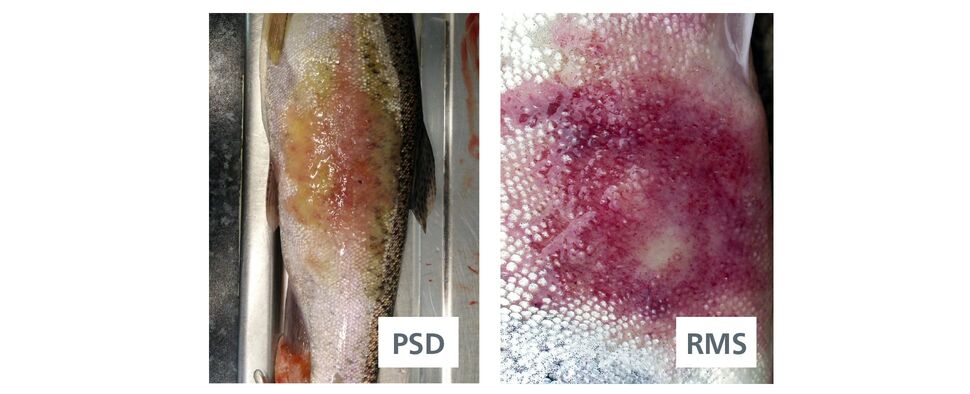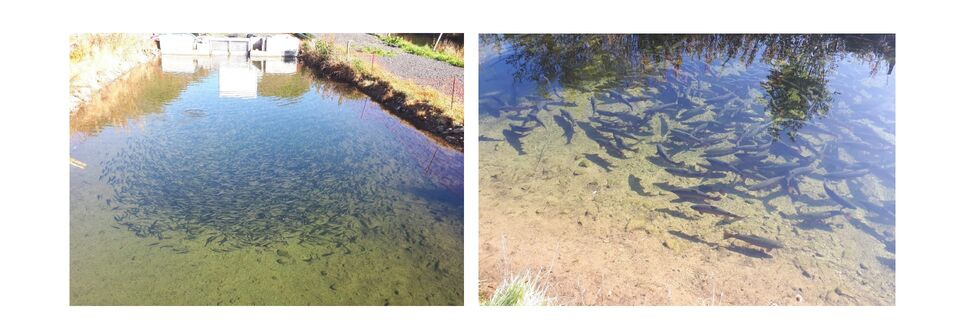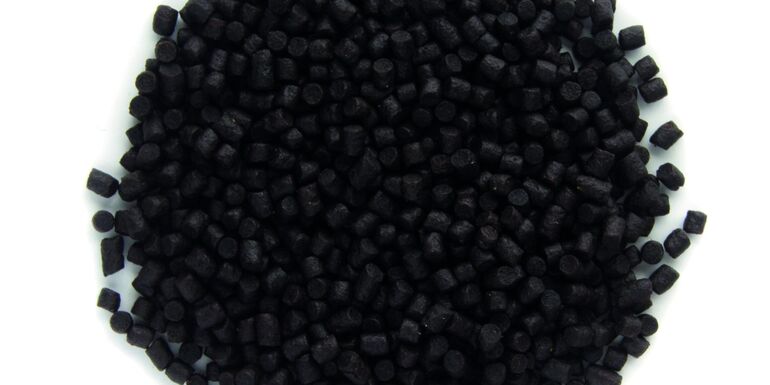
Red mark syndrome (RMS), also known as cold water strawberry disease, is affecting European rainbow trout, with outbreaks reported throughout the continent.
Puffy skin disease (PSD) has many similarities to RMS and strawberry disease (SD). PSD can be differentiated from other skin diseases based on clinical observations and epidemiology. The main problem with RMS and PSD is that, so far, no causative agents have been identified.

How to recognise?
RMS
RMS results in single to multiple skin lesions with full-thickness lichenoid dermatitis. Lesions are usually found around the flanks and affect all layers of the skin. They can, in extreme cases, even affect the underlying muscle tissue. Scale loss is commonly noticed around the lesions, and infiltration of mononuclear cells is seen.
Problem: Loss of market value of the end product due to skin lesions. On the farm, high morbidity numbers (up to 80%) and low mortality levels are common.
PSD
PSD is an emerging skin condition, affecting rainbow trout. The economic losses caused by this are significant. In addition to skin lesions, you may see local loss of skin pigment, decrease in appetite and more lethargic behaviour of the fish. All these elements can be seen with surprisingly low mortality rates. We see hyperplasia and swelling of epidermal cells with infiltration of inflammation cells. PSD has only been reported in rainbow trout. Brown trout seems to be less affected by this.
Problem: Of the mentioned skin diseases, PSD is the only one associated with loss of appetite and growth.

Why are they so common in the UK?
It is clear that a fish’s health, and consequently its immunity, is influenced by many factors and their characteristics. The compounding effect of all these influencing factors will determine the final strength of the immunity and therefore, also the disase severity when a pathogen is introduced into a population.

Healthier fish with a robust immune system are more capable of fighting off intruding pathogens, increasing their chances of survival. By increasing the health status and, therefore, the immunity robustness of a whole population, it is possible to significantly decrease the risk of severe disease outbreaks on-farm.
Alltech Coppens focuses on providing the highest quality feeds for customers. By selecting the best raw materials and functional feed available in the market, Alltech Coppens has developed a full package of all these tremendously important functional feed additives in one product: Aquate™.
Bioplex®, Bio-Mos® and Actigen® have the triple effect of increasing the health status and immunity robustness of the fish. Healthy and robust fish are more likely to perform to their maximum potential, and an optimal feed plays a significant role in this. The gut contains a large proportion of an animal’s immune system, and it is where nutrients are absorbed, as well as where the gut microflora live. The intestinal microbes are known to play a central role in how fish metabolise and use energy from feed. Maintaining good health is an integral part of supporting animal performance by promoting robustness and building natural defences. By promoting a robust innate mucosal system through non-inflammatory response mechanisms, effective barrier protection is created for bacterial and parasitic challenges. Furthermore, the augmentation of the mucosal system promotes a shift in both the microbiology of the gut and a dramatic improvement in its structures, thereby reducing necrosis and enteritis (important areas for pathogen access) and improving gut structural surface area, thus allowing better nutrient uptake and improving growth and performance.

Alltech Coppens’ customer Hoghill Trout Farm in Dumfries, Scotland, has used various fish feeds over the years on his restocking trout. Owner John Kane switched to Alltech Coppens’ Crystal feeds last year and immediately noticed a huge difference in the amount of white faeces that were no longer visible in the ponds.
“The previous feeds I was using from a competitor produced a large amount of white faeces in the ponds that increased suspended solids, fouled the gills of the fish and reduced water quality,” John explained. “Upon switching to Crystal, the white faeces disappeared, and the gills of the fish were noticeably healthier.”
Multiple factors can cause white faeces. Worm infection is one, but also the raw material choices in the feed have a significant effect on the faeces appearance. It is true that some outdoor aqua systems, usually the ones with high volumes of water flushing through the raceways or cages, can flush out the total suspended solids (TSS) quickly, resulting in fewer problems with the fish. Especially for systems more prone to TSS build-up, it is strongly advised to choose feeds that are developed for better digestibility and less faecal production. Although all farms, even farms with high water volumes, could deliberately choose to lower the impact of their organic pollution into the environment. For less organic pollution and better results, we strongly advise Alltech Coppens’ RAS-feeds, like Crystal for trout.

